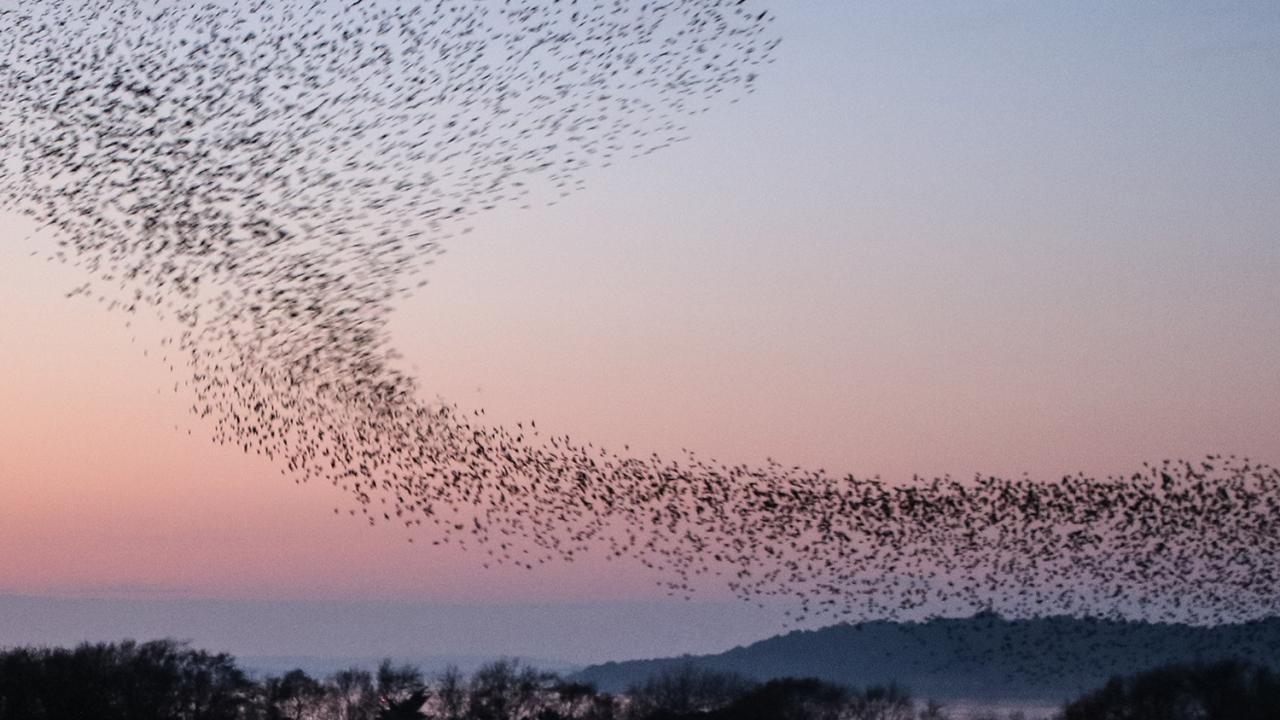
Bird Brain Maps: Study Explores the Neuroecology of Flocking in Birds
Quick Summary
- Researchers investigated neural and ecological factors responsible for flocking in three bird species
- They found that bird brains are messy when it comes to the hormone signaling pathways responsible for flocking
- The study provides bird brain maps as models for neuroecological research
As winter ushers in shorter days, an increase in avian activity occurs over the Yolo Causeway. Plumes of starlings swirl about the dusk-lit sky in ribbons of mesmerizing, coordinated displays called murmurations.
How can we better understand the neural mechanisms that govern these flock formations?
That’s a question on the mind of Naomi Ondrasek, a former postdoctoral researcher in the lab of Assistant Professor Rebecca Calisi Rodríguez.
“Birds are a really neat model for looking at social grouping because they’re conspicuous and because they form groups at different times of year,” said Ondrasek. “There are a lot of bird species that get into groups during the winter and fall period, but when the breeding season hits, they split apart and they set up their own little spaces.”
To explore this phenomenon, Ondrasek and her colleagues investigated the neural and ecological factors responsible for flocking behaviors in European starlings (Sturnus vulgaris), house sparrows (Passer domesticus) and rock doves (Columba livia). Their most recent publication in Frontiers in Neuroscience provides the scientific community with comprehensive brain maps of the hormone receptors that may be involved in the flocking behaviors of these three species.
“These birds are found across a diversity of environments and widely ranging ecological conditions,” said Calisi Rodríguez, a co-author on the paper. “By studying nonapeptide receptors, which appear to be somewhat conserved across vertebrate species, we significantly increase our potential to better understand how and why birds flock in the real world and grouping behaviors in general.”
A confusion of chemicals
In the study, Ondrasek and colleagues focused on two areas of the brain known to have hormone receptors called nonapeptide receptors. These brain areas include the lateral septum, which has a role in bird flocking behavior, and the dorsal arcopallium, the function of which is still under investigation in bird brains. The presumed evolutionary equivalent of the dorsal arcopallium in mammalian brains is involved in social behaviors and emotional processing.
For birds, hormones that bind to nonapeptide receptors in the brain include mesotocin and vasotocin, which are analogous to the mammalian hormones oxytocin, the “love hormone,” and vasopressin. According to Ondrasek, these hormones are integral to social bonding behaviors, which is precisely why she and her colleagues wanted to better understand the layout of these receptors in bird brains.
“Without these kinds of comprehensive maps and binding studies, it’s hard to figure out how these receptors are functioning and whether different receptor types are doing different jobs,” Ondrasek said.
By using a compound called the Manning compound, which is known to have a higher attraction to vasopressin receptors versus oxytocin receptors in the brains of some mammals, the researchers teased out the organization of nonapeptide receptors in bird brains. Because vasotocin receptors are thought to be structurally similar to vasopressin receptors, Ondrasek and her colleagues predicted that the Manning compound would be more attracted to vasotocin receptors than mesotocin receptors.
The researchers found that the Manning compound didn’t showcase a particular attraction to a single receptor type in either the lateral septum or the dorsal arcopallium of all three bird species. In some cases, it showcased a higher attraction to receptors that also bind to a commonly-used label for mesotocin receptors.
The takeaway: bird brains are messy when it comes to these hormone signaling pathways, but the study provides guidelines and lays out maps that will help researchers use these birds as models for future neuroecological studies.

New maps for further exploration
Ondrasek sees many lines of inquiry she and other researchers could follow-up on. In house sparrows, researchers could study the neuroecology of social foraging behaviors, investigating how resource availability affects their brain chemistry and thus the formation of groups. In starlings, researchers could study how seasonality impacts social behaviors, defining their brain chemistry during the winter, when they group in murmurations, and during the breeding seasons, when they split off from the group and establish their own territories.
“Now that we have these maps, I’m hoping people will pick up on this and say, ‘Yeah, I want to go collect birds from a variety of environments and see how their grouping behaviors and brains are different,’” Ondrasek said. “Because these species all have different profiles, we can use them to ask really different, but equally important questions.”
Bringing science to the legislature
Currently, Ondrasek works as a science policy fellow with the California State Assembly Education Committee. Though no longer donning the lab coat, she sees opportunities to connect her previous bird brain research and her policy work, since nonapeptide systems are conserved across species, including humans.
“There are the fascinating ecology questions, but there are also the more humanistic questions,” she said. “How can we understand the role that our brains and our environment play in what we’re doing, and how can we use that to inform public policy?”
With the legislature, Ondrasek investigates issues surrounding K-12 education policy, including how the physical environment and access to resources affect developmental processes that are key to educational success. For her, it’s about figuring out how science can help alleviate human problems and conflict.
“There are real physical mechanisms in our brains that impact the things we do every day, so understanding the brain has real global policy implications,” she said. “I’d love for people to think more about that.”
